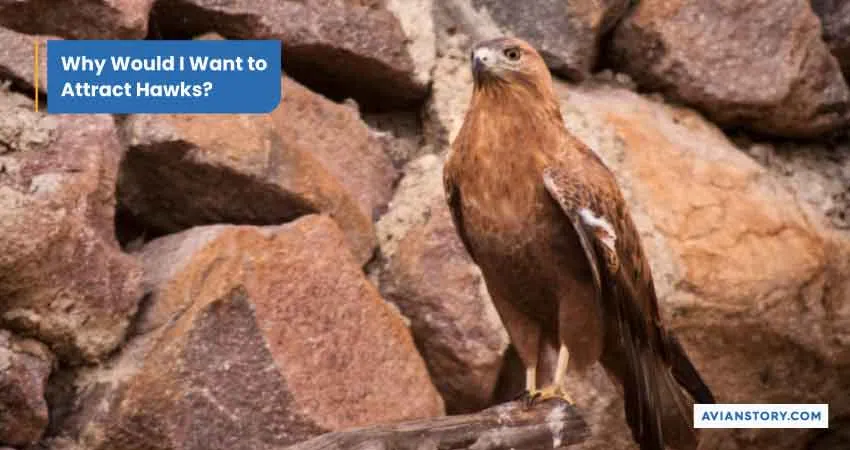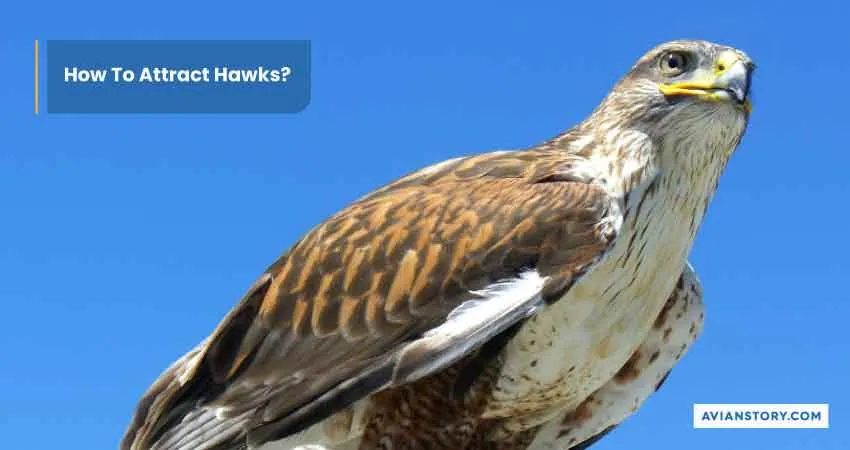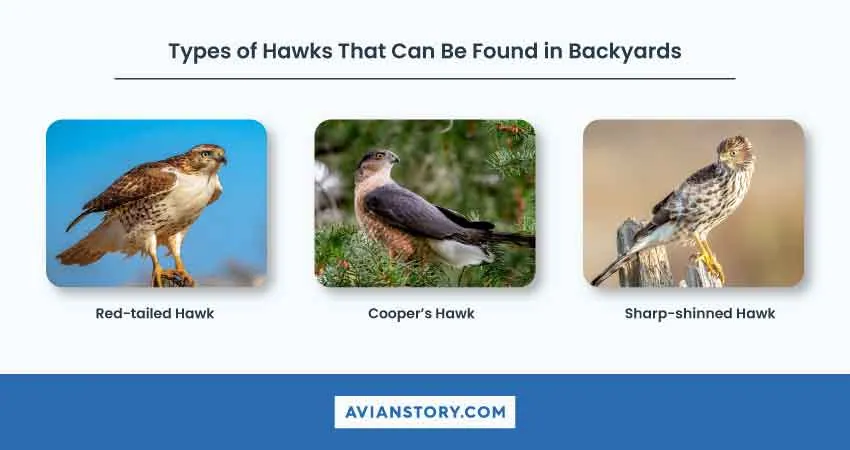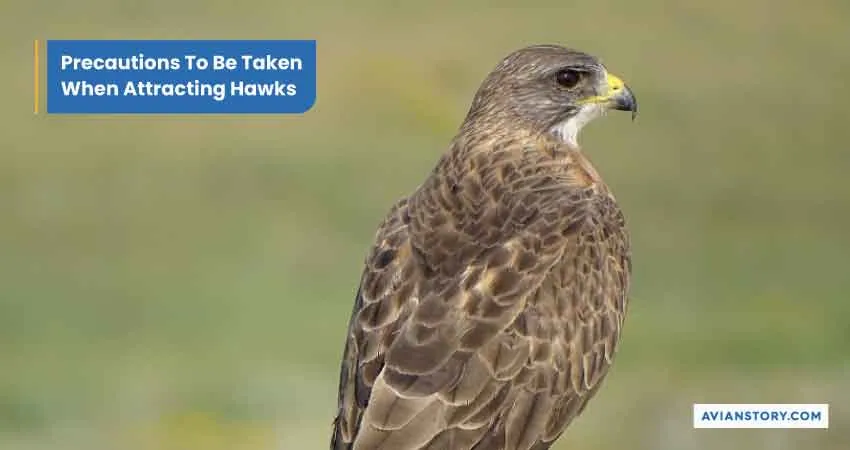How to Attract Hawks to Your Backyard in 4 Simple Steps
Hawks serve a purpose beyond being predators. Since time immemorial, most of us have relished the sight of hawks in the wild. However, when we spot one in our homes, it is not as pleasing. Therefore, the thought of one trying to attract hawks to their backyard may seem weird and inappropriate.
But how to attract hawks? Provide a suitable habitat with shelter, abundant food sources, and accessible water to attract hawks. Also, hawks only thrive in environments they deem to be as natural as those in the wild. You can erect nesting points and ensure your backyard is as quiet as possible.
Indeed, hawks occasionally prey on unsuspecting animals in your yard. Continue reading to learn how to attract hawks and other related topics.
Why Would I Want to Attract Hawks?

Attracting hawks to your backyard may appear to be an unusual aim, but there are several convincing reasons why it is desirable. Let’s look at why you might want to attract hawks:
Ecological Balance
Hawks play an important role in maintaining a healthy ecosystem. As formidable predators, they aid in controlling populations, such as snakes, which can otherwise become problematic.
Other food sources include rats, mice, frogs, lizards, and various large insects. Inviting hawks into your backyard helps the natural pest control cycle, which reduces the need for chemical interventions.
Bird-Watching Purposes
Hawks are enthralling creatures that exude grace and power. Furthermore, according to a study by Canadian ornithologist Louis, they are among the world’s smartest birds.
Their impressive aerial displays, soaring flights, and precise hunting techniques provide a one-of-a-kind and awe-inspiring spectacle. So, by attracting hawks, you create opportunities to observe their behavior up close.
Unique Photography Opportunities and Aesthetic Pleasure
Attracting hawks to your backyard can provide opportunities to capture stunning images of these birds. You can take pictures of them either in flight, perched on branches, or engaged in hunting behavior. This adds excitement and beauty to your outdoor space.
How To Attract Hawks? – 4 Simple Steps

The main tip of attracting hawks is meeting their food, water, and shelter needs. Here are some effective methods to make your backyard more hawk-friendly:
Food Source
Smaller birds, such as finches, sparrows, doves, and thrushes, are frequently hunted by backyard hawks. As a result, attracting various birds to your backyard is an effective way to provide a food source for hawks. You can do the following to set this food source for hawks.
- Set up a well-stocked bird feeding station with various feeders and appropriate birdseed to attract small birds. As these birds congregate to feed, they become potential prey for hawks.
- Encourage a healthy population of small birds. This will increase the likelihood of attracting hawks looking for an easy meal.
- In addition to bird feeders, it is critical to have other natural food sources available in your backyard, such as insects and rodents.
- Provide your backyard with bushes and plenty of vegetation to attract rodents.
- Also, avoid using pesticides that may harm the insect population, as insects are essential to the hawk’s diet.
However, intentionally feeding hawks, pet mice, raw meat, or other treats is unacceptable. Hawks are wild animals that must rely on their natural hunting instincts and available prey.
Water Source
Although hawks do not regularly drink water to hydrate, they need water for bathing, cooling off, and keeping their feathers in optimal condition.
- So, creating water sources for hawks can be accomplished through various means. They include concrete bird baths, ground bird baths, and bath fountains.
- The baths must be larger, sturdier, and deeper to accommodate these raptors.
- Another advantage of bird baths is attracting small birds and rodents, which serve as a food source for hawks.
Erect Perches
Hawks require vantage points to observe their surroundings and plan their hunting strategies. These perches can be tall trees, such as conifers. While trees are their preferred perching spots, not all backyards have abundant suitable trees.
- In such cases, alternative perches for hawks to land on become necessary.
- Artificial perches can be made from branches or wooden planks. Choose branches or planks that are 1 to 3 feet long.
- Nail them to dead trees or strong fence posts to keep them secure. It is critical to carry out this activity only on your property and if no natural perches are available.
- Ascertain that the perches are strategically placed to provide unobstructed views of the surroundings and nearby feeding areas.
Put Up Nesting Areas
Hawks often use the same large trees they perch on to nest. However, if there are no large trees in your backyard, you can build a nesting platform for the hawks. Here is how to make the platform.
- Prepare nine sturdy wooden platforms with dimensions of approximately 2 feet by 2 feet (60 cm by 60 cm). Use weather-resistant wood, like cedar or marine-grade plywood.
- Place two wooden pieces horizontally and parallel to each other, about 2 feet (0.61 m) apart.
- Place two more wooden pieces vertically across the top ends of the first two, forming a square shape.
- Using a power drill, drive the screws through the top pieces and into the ones below. It is recommended to use corrosion-resistant screws, such as galvanized decking screws.
- Lay three more pieces flat across the bottom pieces, filling in the top of the platform.
- The arrangement of these pieces should resemble the slats of a bed frame.
- Then, obtain two long wooden posts, about 8 to 12 feet (2.5 to 3.7 meters) in length.
- Choose a suitable location for installation. And dig two holes in the ground that are deep enough to accommodate the length of the wooden posts.
- Insert the wooden posts into the holes and tamp the soil firmly around them to provide stability.
- To securely fasten the platform to the top of the post, set up an extension ladder and ensure it is stable and secure. Climb the ladder and take the two remaining pieces of wood with you.
- Once you reach the desired height, attach the two pieces of wood to the top of the post. Position one piece on each side of the post to form joists.
- Once the joists are in place, screw the platform onto the joists to firmly attach it.
- You may cover the platform with grass to hide the screws. This gives it a more natural look.
Here is a video to help you out visually.
Maintain A Natural Environment In Your Backyard
Hawks are patient birds that hunt their prey using stealth and surprise. It is critical to keep your yard quiet to accommodate their hunting behavior.
So, avoid making excessive noises or causing disturbances that may startle or deter hawks.
Also, do not add too many human elements in your yard, for example, toys and trampolines. This might discourage hawks from coming to your backyard.
Minimize Pruning and Heavily Groomed Landscaping
Hawks are more at ease in habitats similar to their natural surroundings.
- Reduce pruning and heavily groomed landscaping practices that result in an overly manicured appearance.
- Instead, embrace a more natural aesthetic by allowing plants and shrubs to grow to mimic a native habitat.
This type of landscaping provides a suitable environment for hawks. It also supports a thriving ecosystem of prey species on which hawks rely on for sustenance.
Types of Hawks That Can Be Found in Backyards
Here are some common types of hawks that you might encounter in your backyard:

- Red-tailed Hawk: With its broad wings and reddish-brown tail, it is frequently seen soaring high in the sky or perched on tree branches. Red-tailed Hawks are adaptable hunters and often catch various prey, including rodents, small mammals, and birds.
- Cooper’s Hawk: Cooper’s Hawks are agile and fast-flying birds commonly found in woodland habitats. Cooper’s Hawks prey on smaller birds such as doves, sparrows, and finches. So, their presence in backyards is often associated with an abundance of small bird species.
- Sharp-shinned Hawk: These hawks have short wings and long tails that help them maneuver through dense vegetation. They are frequent visitors to backyards with bird feeders, taking advantage of the plentiful food source.
Precautions To Be Taken When Attracting Hawks

It is important to consider the following precautions to ensure the well-being of the birds and your backyard ecosystem.
Safety for Small Pets
Hawks are predatory birds that may see small pets like cats and dogs as potential prey. To ensure their safety, keep small pets indoors or under supervision while hawks are in your backyard. This precaution reduces the possibility of any conflicts or harm to your beloved pets.
Avoid Excessive Handling or Disturbance
Hawks are wild birds that should be observed safely. Avoid attempting to handle or approach them closely, as this can cause unnecessary stress and disrupt their natural behaviors. Maintain a safe distance and use binoculars or a spotting scope to observe their activities without invading their space.
Minimize the Use of Chemicals
Limiting the use of chemicals such as pesticides and herbicides is best to maintain a healthy backyard ecosystem. These chemicals may have unintended negative effects on the hawk’s prey, harming the hawk if it consumes a poisoned rodent.
Avoid Deliberate Feeding
While providing additional food to attract hawks may be tempting, it is not recommended. Hawks are skilled hunters who should rely on their instincts to locate prey.
Respect Local Laws and Regulations
Before engaging in any hawk-attracting activities, it is critical to familiarize yourself with local wildlife conservation laws and regulations. Some areas have specific guidelines in place to protect birds of prey.
Allow Hawks Time to Digest
After hawks have successfully hunted and fed in your backyard, resist the urge to shoo them away. Raptors need time to digest their meals and rest before they can resume hunting activities. If hawks feel pressed or rushed, they may be less likely to return to the same hunting grounds.
FAQs
In addition to the above, you should know about the following queries.
When should I expect to see hawks?
The timing of hawk sightings can vary depending on your location and the specific species in your area. Conversely, Hawks are frequently observed during their spring and early summer breeding season, actively searching for nesting sites and food sources.
What other types of birds of prey might be attracted to my yard?
In addition to hawks, your efforts to attract these birds may attract other raptors, such as eagles, owls, falcons, and vultures.
What can I do if hawks become a nuisance?
Hawks can become a nuisance in some cases, especially if they consistently prey on smaller birds or pose a threat to livestock. In such cases, seek advice from local wildlife authorities. You can also seek advice from bird conservation organizations on humane and ethical conflict resolution methods.
Long Story Short
Attracting hawks to your backyard provides an incredible opportunity to connect with nature’s wonders. Thus, you can gain a deeper understanding of these magnificent birds of prey. Besides, you can create an inviting habitat for hawks by following the strategies outlined in this article.
Hawks contribute to ecological balance by controlling rodent populations and adding a touch of natural beauty to your outdoor space. Attracting hawks necessitates patience, respect, and adherence to local regulations.
